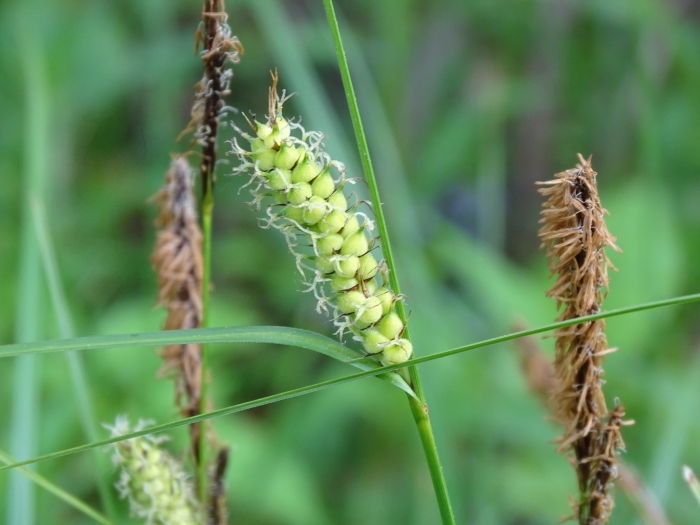Woolly Sedge
(Carex pellita)
Woolly Sedge (Carex pellita)
/
/

Reuven Martin
Public Domain
Image By:
Reuven Martin
Recorded By:
Copyright:
Public Domain
Copyright Notice:
Photo by: Reuven Martin | License Type: Public Domain | License URL: http://creativecommons.org/publicdomain/zero/1.0/ | Rights Holder: Reuven Martin | Publisher: iNaturalist | Date Created: 2020-05-30T07:46:29-07:00 |

















































Estimated Native Range
Summary
Carex pellita, commonly known as Woolly Sedge, is a deciduous or semi-deciduous perennial sedge native to wet meadows, marshes, and the edges of water bodies in North America, extending to Northeastern Mexico. This sedge forms dense colonies through a network of spreading rhizomes, with clumps of stems reaching 30 centimeters to 1 meter (3 feet) in height. The inflorescence, up to 30 centimeters long, is a cylindrical spike composed of overlapping flowers. Female flowers are notable for their dark brown or purplish, hairy scales with elongated tips. The fruit is enveloped in a distinctive fuzzy to woolly perigynium, adding to the plant’s textural interest.
Woolly Sedge is valued for its ability to stabilize soil and its adaptability to wet conditions, making it suitable for rain gardens, water edges, and naturalized areas. It thrives in full sun to part shade and requires high amounts of water, preferring soils with slow to wet drainage. While it is not typically known for showy flowers, its textural foliage and seed heads provide visual interest. Woolly Sedge is also used in restoration projects due to its ecological benefits, including providing habitat for wildlife. Gardeners should note that it can spread vigorously in suitable conditions, which may be a consideration in smaller garden settings.CC BY-SA 4.0
Woolly Sedge is valued for its ability to stabilize soil and its adaptability to wet conditions, making it suitable for rain gardens, water edges, and naturalized areas. It thrives in full sun to part shade and requires high amounts of water, preferring soils with slow to wet drainage. While it is not typically known for showy flowers, its textural foliage and seed heads provide visual interest. Woolly Sedge is also used in restoration projects due to its ecological benefits, including providing habitat for wildlife. Gardeners should note that it can spread vigorously in suitable conditions, which may be a consideration in smaller garden settings.CC BY-SA 4.0
Plant Description
- Plant Type: Grass, Grass
- Height: 0.5-1.5 feet
- Width: 1-1.5 feet
- Growth Rate: Moderate
- Flower Color: N/A
- Flowering Season: Spring, Summer
- Leaf Retention: Deciduous, Semi-Deciduous
Growth Requirements
- Sun: Full Sun, Part Shade
- Water: High
- Drainage: Slow, Medium, Wet
Common Uses
Bird Garden, Deer Resistant, Low Maintenance, Water Garden
Natural Habitat
Wet meadows, marshes, and edges of water bodies
Other Names
Common Names: Broad-Leaved Woolly Sedge, Carex Laineux
Scientific Names: , Carex pellita, Diemisa pellita,
GBIF Accepted Name: Carex pellita Muhl. ex Willd.